MERAWEX ZUP-230V User manual

User Manual ZUP-230V + ZSP121N-DR Nr dok. 0697.00.95-12.0
MERAWEX Sp. z o.o.
ul. Toruńska 8
44-122 Gliwice, Poland
tel. +48 32 23 99 400
fax +48 32 23 99 409
e-mail: m[email protected].pl
http://www.merawex.com.pl
USER MANUALS FOR POWER SUPPLY ZUP-230V
The document contains:
USER MANUAL
Power supply for fire alarm devices, heat and smoke control systems, fire protection and fire
automation systems.
ZUP-230V-400, ZUP-230V-700, ZUP-230V-1000, ZUP-230V-1500
and
USER MANUAL
Power supply for fire alarm devices, heat and smoke control systems, fire
protection devices and fire automation
ZSP121N-DR
designed to operate with the power supply ZUP-230V
14.05.2018

User manual ZUP-230V Nr dok. 0697.00.95-02.3 1/15
MERAWEX Sp. z o.o.
Toruńska 8
44-122 Gliwice, Poland
tel. +48 32 23 99 400
fax +48 32 23 99 409
e-mail: m[email protected].pl
http://www.merawex.com.pl
USER MANUAL
Power supply for fire alarm devices, heat and smoke control systems, fire protection and fire
automation systems.
ZUP-230V-400, ZUP-230V-700, ZUP-230V-1000, ZUP-230V-1500
Meeting the EN 54-4 and EN 12101-10
Certificate of constancy of performance CNBOP No. 1438-CPR-0593
Certificate of admittance CNBOP No. 3183/2018
14 May 2018
Technical description......................................................................................................2
1.1. Application................................................................................................................................2
1.2. Technical data. .........................................................................................................................3
Construction. ..................................................................................................................4
Functioning of outputs. ...................................................................................................6
Description of 230Vac distribution packet of ZUP power supply......................................9
Installation....................................................................................................................10
5.1. General notes........................................................................................................................ 10
5.2. Connecting mains.................................................................................................................. 11
5.3. Connection of external AC output circuits ............................................................................. 11
5.4. Connection of additional outputs........................................................................................... 11
5.5. Connection of battery bank.................................................................................................... 11
5.6. Connection of alarm input from fire alarm control panel (CSP)............................................. 12
5.7. First start................................................................................................................................ 12
5.7.1. Starting power supply.................................................................................................... 12
5.7.2. Checking basic functions............................................................................................... 13
5.7.3. Setting time.................................................................................................................... 14
Additional information...................................................................................................14
6.1. Manufacturer's notes ............................................................................................................. 14
6.2. Proceeding with packaging, used products and batteries..................................................... 14

User manual ZUP-230V Nr dok. 0697.00.95-02.3 2/15
Warnings
▪Before using the device, carefully read this User Manual.
▪Do not touch the internal components of the operating device - risk of electric shock or
burns.
▪Protect the device against any objects or liquids entering it - risk of electric shock and
damage to the device.
▪Do not obscure the ventilation openings - it can damage the device.
▪Provide at least free space of at least 10cm on the sides of the device allowing proper
ventilation.
▪It is forbidden to transport the device with mounted and connected batteries.
▪The device must be powered from the mains with a protective earth terminal.
▪The device may affect the operation of sensitive radio and television equipment located
nearby
Technical description.
1.1. Application.
The ZUP-230V battery backup power supply provides the 230V uninterruptible voltage from the
mains or after its failure, from the DC/AC 230Vac inverter powered from the internal 24V battery bank.
During power failure, the total power is taken from the battery, its presence and efficiency is an
essential element of the power supply’s operation.
The power supply is not an UPS. Most fire protection devices supplied with 230V voltage during
supervision stay in standby mode - no power is consumed. The organization of the power supply’s
work takes into account this fact by setting specific time periods of the inverter's activity, while it takes
energy from the battery. Apart from those time periods the battery is relieved while waiting for a fire
alarm. This allows to extend the supervision time to 72h while maintaining the readiness to operate
powered devices with full power (depending on the type 400 ÷ 1500W).
The power supply enables 230V voltage distribution among 4 various types of receivers requiring
taking, switching or disconnection of power at a given time, depending on a function being performed,
after receiving a signal from outside (e.g. fire alarm). Response times for individual types of outputs
can be set by a user in a wide range by using slide switches. The main application of the ZUP-230V
power supplies includes:
•aeration gates;
•shunt trips of fire protection circuit breakers;
•self-locking, two-way actuators of shutting off dampers of fire ventilation;
•drives of the fire zone separating gates;
•spring actuators of fire protection shutting off dampers;
•blinds of ceiling smoke tanks;
•smoke exhaust fans running after a shutting off damper goes to the opening position;
•self-locking, two-way actuators of fire protection shutting off dampers, closed when a fan
stops;
•devices started in a cascade sequence to reduce the inrush current.
In addition, the 24Vdc uninterruptible voltage of 100W is available to supply other fire protection
devices.
The power supply meets the requirements of the EN 54-4: 2001 + A1: 2004 + A2: 2007 and EN
12101-10: 2007 and the Ordinance of the Ministry of Interior and Administration of the 20 June 2007,
the Book of Acts No. 143 item 1002, with an amendment No. 85 item 553 of 27/04/2010.
In addition, the power supply meets the requirements of the Regulation of the European
Parliament and the Council of Europe (EU) No. 305/2011 of the 9 March 2011. (CPR - Construction
Product Regulation).

User manual ZUP-230V Nr dok. 0697.00.95-02.3 3/15
1.2. Technical data.
Basic operating parameters of power supplies.
EN 54-4
Max. battery
capacity
Imax_a
Imax_b
230Vac
24Vdc
230Vac
24Vdc
ZUP-230V-400
45Ah
400 W
2.0 A
400 W
3.5 A
ZUP-230V-700
45Ah
700 W
1.9 A
700 W
3.3 A
ZUP-230V-1000
45Ah
1000 W
1.7 A
1000 W
3.2 A
ZUP-230V-1500
75Ah
1500 W
0.4 A
1500 W
3.0 A
EN 12101-10
Max. battery
capacity
Imax_a
Imax_b
230Vac
24Vdc
230Vac
24Vdc
ZUP-230V-400
45Ah
0 W
0.33 A
400 W
3.5 A
ZUP-230V-700
45Ah
0 W
0.26 A
700 W
3.3 A
ZUP-230V-1000
45Ah
0 W
0.15 A
1000 W
3.2 A
ZUP-230V-1500
75Ah
0 W
0.41 A
1500 W
3.0 A
Holes inthe
cabinet's bottom
ZUP-230V 8
Dimensions and weight
A
B
C
D
E
F
G
Weight with
battery
ZUP-230V-400 -700 -1000
455
406
207
438
310
360
410
42 kg 45Ah
ZUP-230V-1500
555
456
207
488
410
410
470
65 kg 75Ah
Fig.1. Dimensions and placement of mounting holes of ZUP-230V power supplies.
Basic electrical and environmental parameters.
Power
Mains voltage
230V - 25% +10% 50Hz
Outputs 230Vac *1)
Output voltage 230Vac
- when mains present *2)
- when mains absent *2)
equals to mains voltage
230V ±3% 50Hz *3)
Fuses on each output
5x20mm 6.3AF
Output 24Vdc
Rated voltage of output 24Vdc *4)
27.1V
Range of voltage changes 24Vdc *5)
21…28.8V
Battery bank
Maximum battery charging current
- battery of 45Ah
- battery of 47Ah
1.7A
2.8A
Quiescent current consumption from battery
- when inverter is operating
- when inverter is off
0.78A/400W, 0.93A/700W,
1.08A/1000W, 1.33A/1500W
26mA

User manual ZUP-230V Nr dok. 0697.00.95-02.3 4/15
- after disconnection of discharged battery
0.33mA
Maximum, additional resistance in battery circuit Ri max. *6)
25mΩ/45Ah; 19mΩ/75Ah
Environment
Operating temperature
-5…+40°C
Level of security EN 60529:2003
IP 42
*1) The power and output circuits of 230Vac have the common conductor N.
*2) The presence of the mains voltage is recognized for the voltage of above 184V ±11V.
*3) The voltage is not synchronized with the mains voltage.
*4) With a battery charged at 25
C.
*5) The specified range includes the voltage between the voltage of the discharged battery bank (at the end of the
battery cycle) and the voltage of the bulk charging.
The detailed description of the ZSP121N-DR power supply operation is included in a separate User Manual.
*6) The markings according to the EN 54-4 + A1 + A2 standard
Standards compatibility
Electrical safety
EN 60950-1:2007 + A1:2011 class I
Functionality
EN 54-4:2001 + A1:2004 + A2:2007
Functionality class
EN 12101-10:2007 class A
Environmental class
EN 12101-10:2007 class 1
Radio disturbances
EN 55022:2013 class B
EMC immunity
EN 50130-4:2012 + A1:2015
EMC emission
EN 61000-3-2:2007 + A1:2010 + A2:2010
EN 61000-3-3:2011
Construction.
Power supply assembly
Equipment
Quantity
Notes
Power supply ZUP-230V
1
Battery bank 12V
2
Capacity depends on type of power supply
Temperature sensor
1
For power supply ZSP121N-DR
Cable (connector) of battery bank
1
Equipped with 2 ring cable lugs Ø6
Glands M16×1.5
2
Quantity can be changed when ordering
Glands M20×1.5
3
Quantity can be changed when ordering
Note
The power supply casing has holes protected with glands prepared for mechanical removal during
assembly:
•in the upper part for 5 M16 × 1.5 glands and 7 M20 × 1.5 glands;
•in the lower part for 3 M16 × 1.5 glands and 5 M20 × 1.5 glands.
The possible location of all glands on the power supply casing is shown in Fig.1.
The simplified diagram of the power supply is shown in Fig.2. The power supply includes:
•main 230Vac power distribution block (ZUP);
•24Vdc/230Vac inverter;
•24V battery bank;
•ZSP121N-DR power supply, basic function of which is charging and supervision of the
battery bank and powering 230V power distribution block.
This manual suits for next models
4
Table of contents
Other MERAWEX Power Supply manuals

MERAWEX
MERAWEX ZSP135-DR-2A-1 User manual
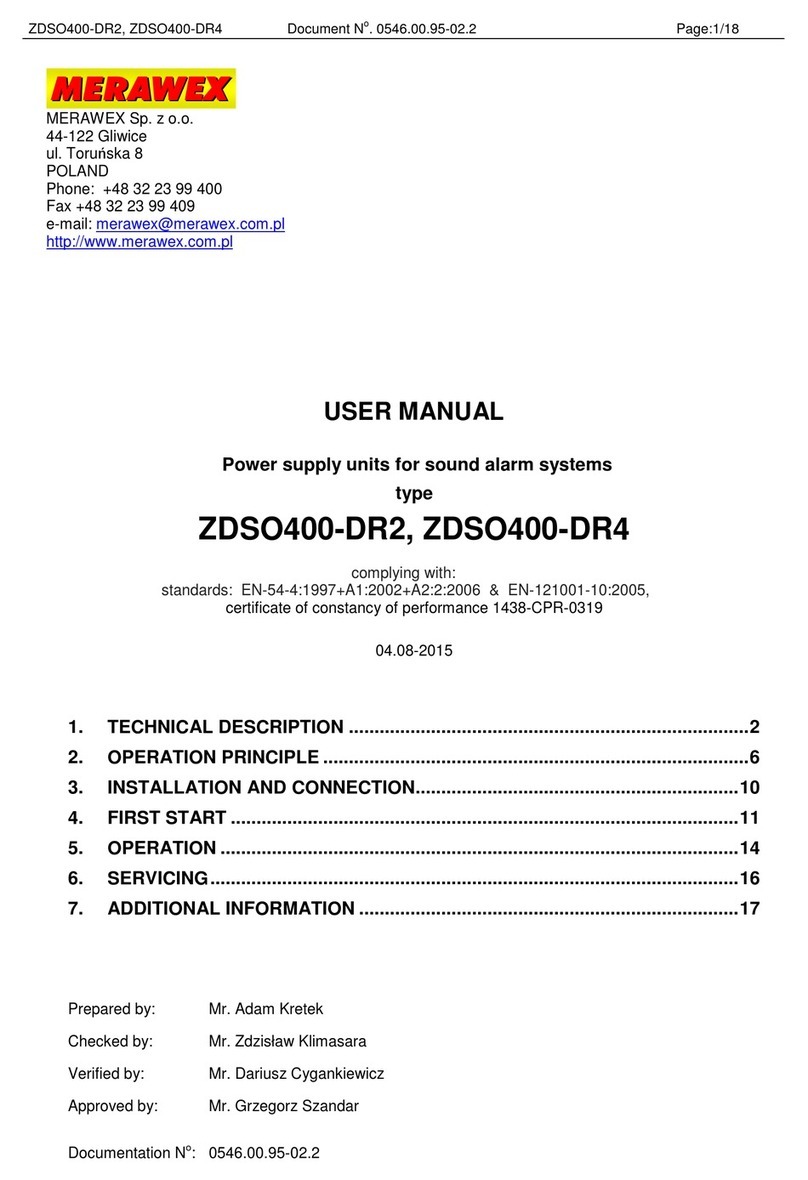
MERAWEX
MERAWEX ZDSO400-DR2 User manual
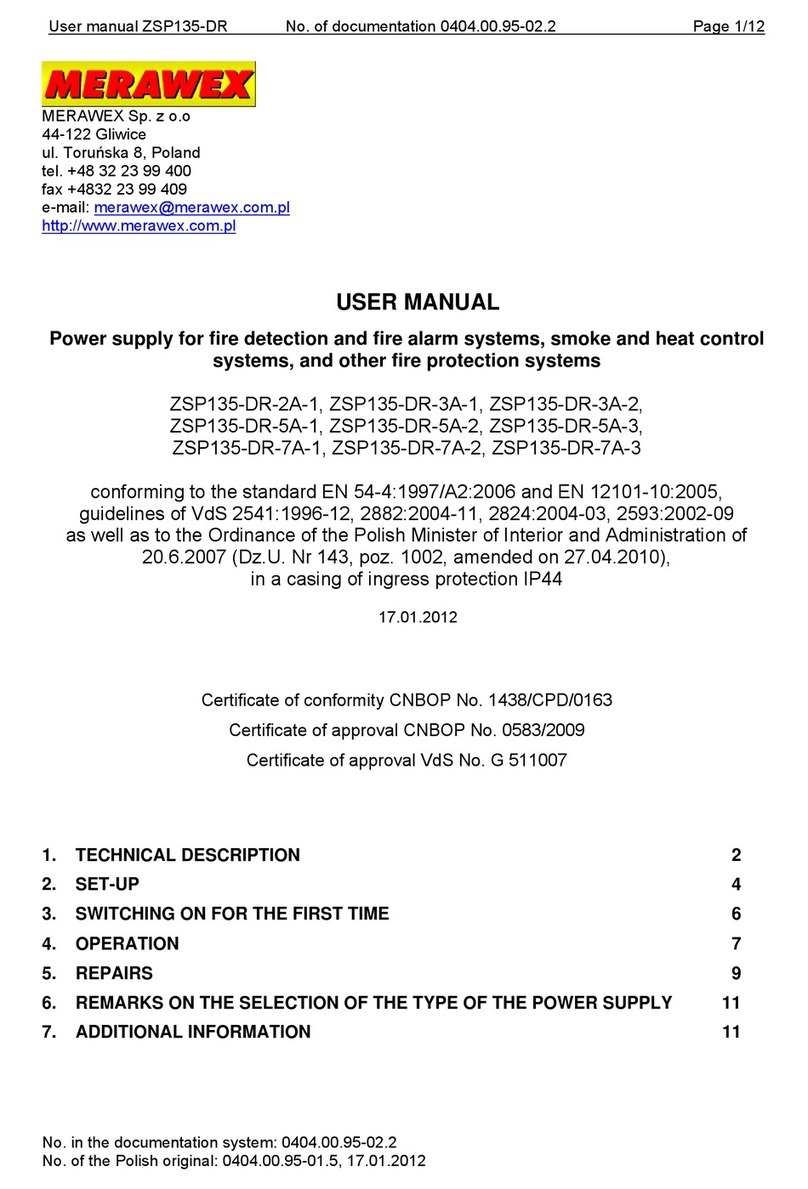
MERAWEX
MERAWEX ZSP135-DR-2A-1 User manual

MERAWEX
MERAWEX ZSP100 Series User manual
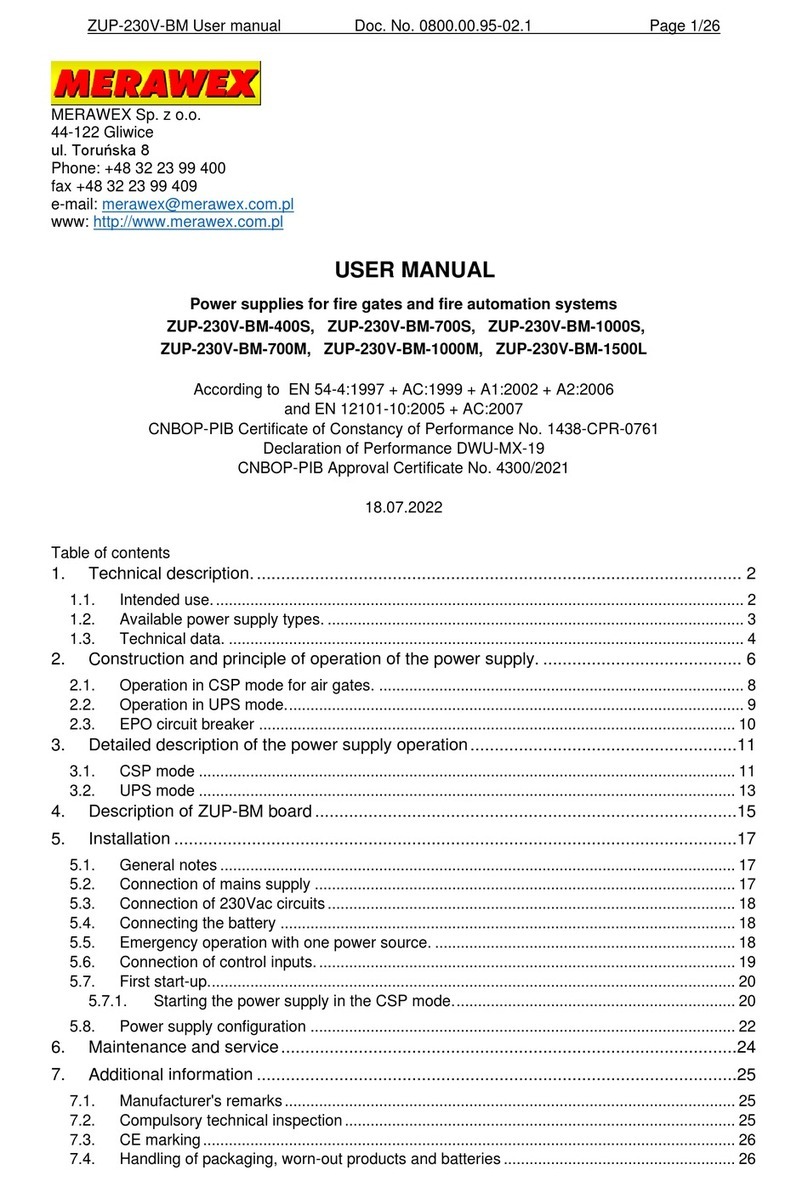
MERAWEX
MERAWEX ZUP-230V-BM-400S User manual
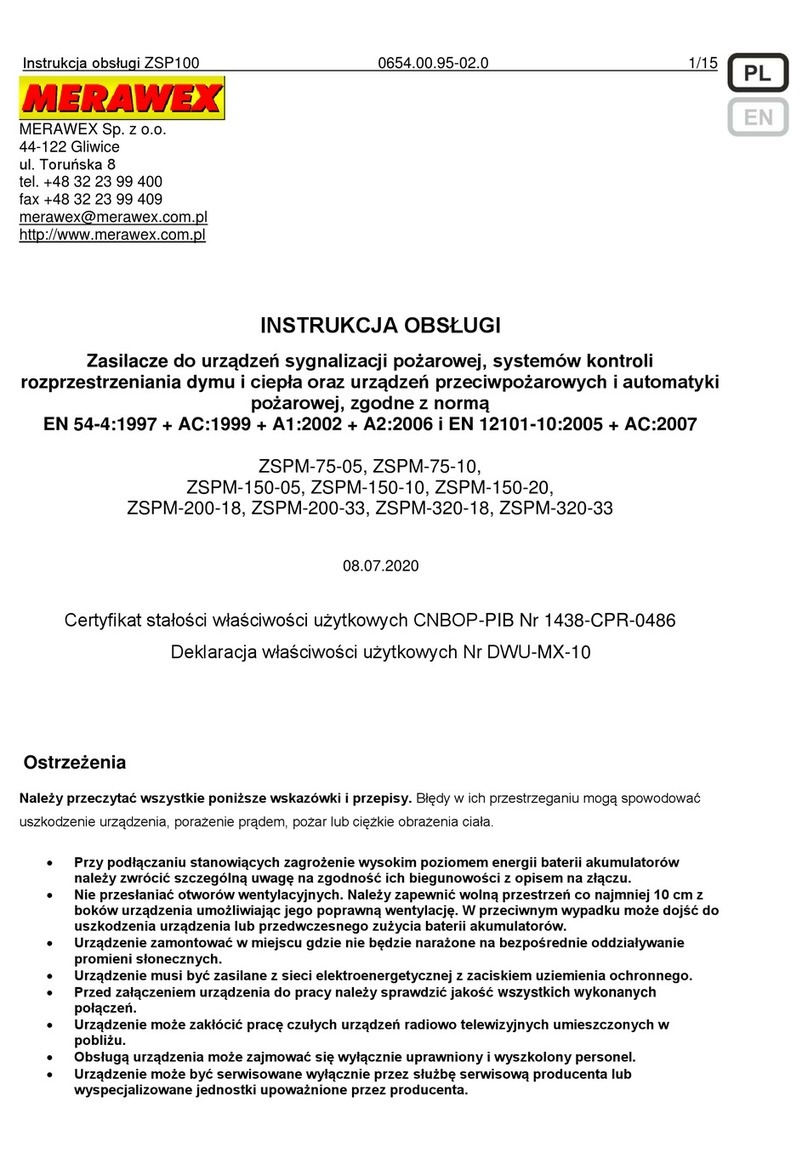
MERAWEX
MERAWEX ZSPM-75-05 User manual
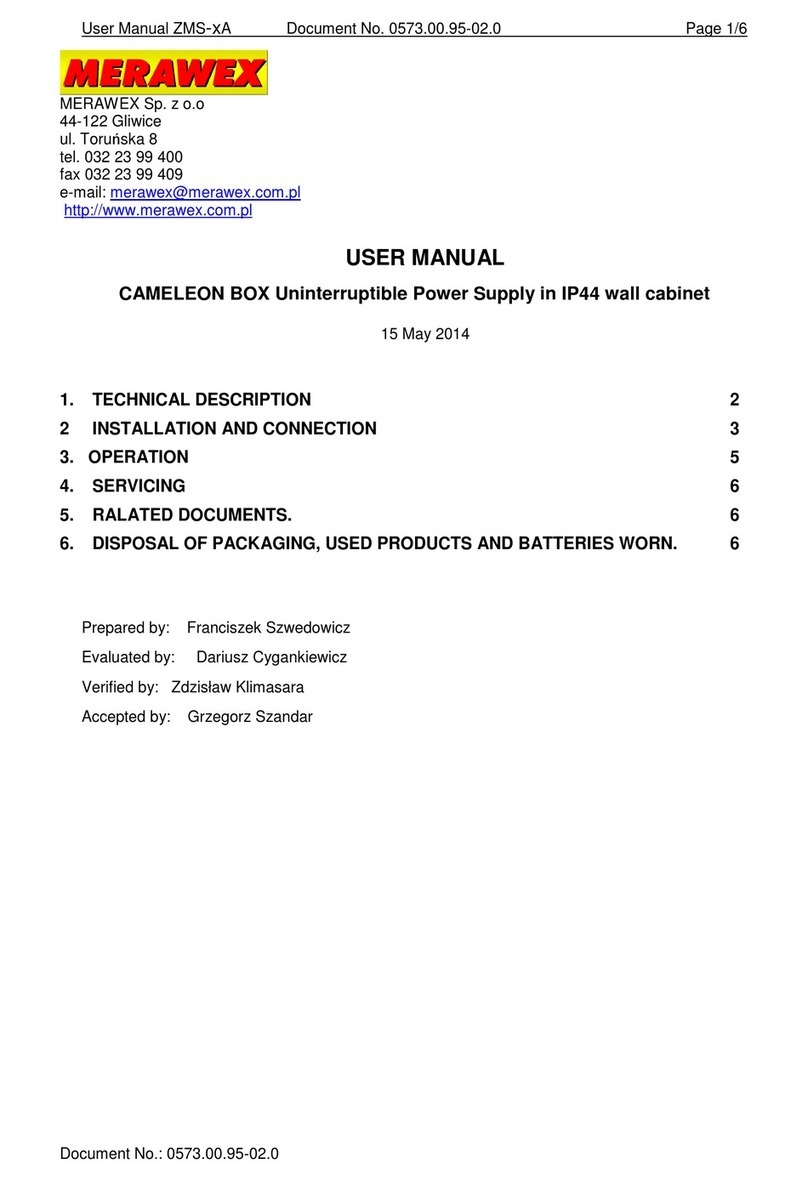
MERAWEX
MERAWEX ZMS-1A-12V10A User manual
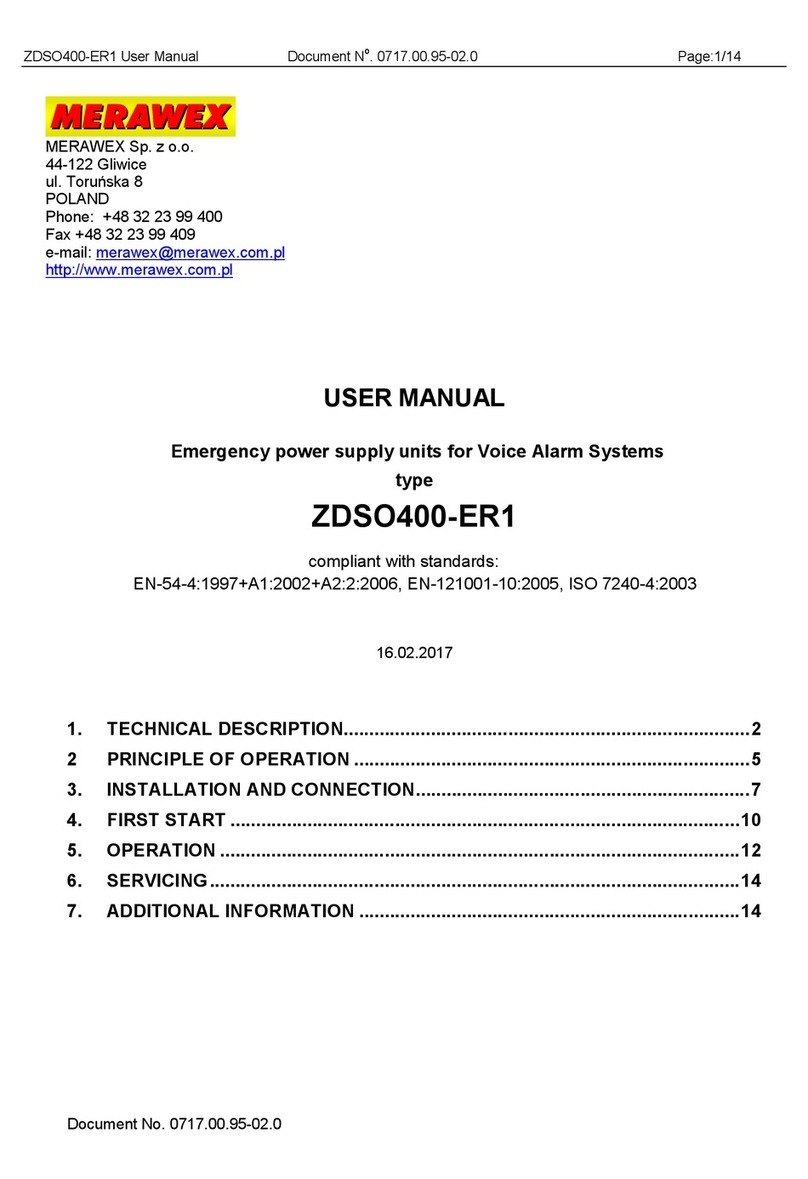
MERAWEX
MERAWEX ZDSO400-ER1 User manual
Popular Power Supply manuals by other brands

Videx
Videx 520MR Installation instruction

Poppstar
Poppstar 1008821 Instructions for use

TDK-Lambda
TDK-Lambda LZS-A1000-3 Installation, operation and maintenance manual

TDK-Lambda
TDK-Lambda 500A instruction manual

Calira
Calira EVS 17/07-DS/IU operating instructions

Monacor
Monacor PS-12CCD instruction manual











